#Quaternary
Explore tagged Tumblr posts
Text

Huh, ya think it might have rained a little back then?
#maybe a little flood#possibly from some glaciers#could’ve occurred during the last ice age#but I guess we’ll never know#real tags now#geology#sedimentary rock#quaternary#Columbia basin#sedimentary structure
183 notes
·
View notes
Text

It’s time to give the animals of the Cenozoic a day in the limelight…
#cenozoic mammals#cenozoic era#cenozoic#works in process#work in progress#work in process art#work in progress art#art wip#wip#mammoths#wooly mammoth#wooly rhino#smilodon#basilosaurus#andrewsarchus#brontothere#paraceratherium#deinotherium#hominids#paleocene#eocene#oligocene#miocene#pliocene#pleistocene#pleisotcene megafauna#paleogene#neogene#quaternary#megalodon
478 notes
·
View notes
Text
Monday Musings: Understanding Geologic Time

Deep time is not an easy thing to try and comprehend and it certainly doesn’t help when there’s all these crazy names being thrown at you. Let’s take a moment to break it down and really understand what we are seeing. The largest unit of geochronologic time is an eon. There are four formally defined eons: the Hadean, the Archean, the Proterozoic, and the Phanerozoic. The Hadean Eon is the oldest eon going from 4.6-4 Ga years ago. Its name is derived from the Greek god, Hades in reference to the still molten surface of the newly formed planet.
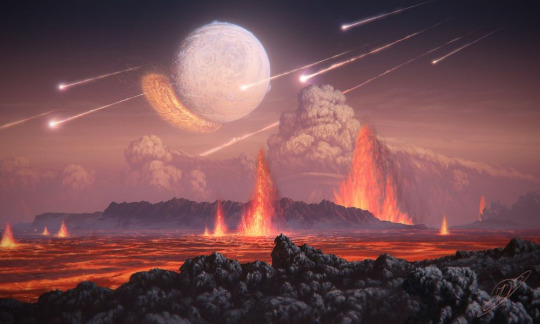
Following the Hadean Eon is the Archean Eon. This eon went from 4-2.5 Ga years ago. As mentioned in my Barberton Greenstone Belt video two weeks ago, this eon saw the creation of oceans and mountains as well as the appearance of the first living organisms known as stromatolites which would put oxygen into the atmosphere. Archean means “beginning or origin” which is fitting.
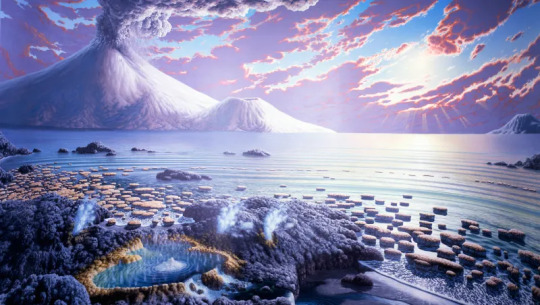
Next came the Proterozoic Eon. Lasted from 2.5 Ga-545 Ma. During this eon, the atmosphere became oxygenated, there were several glaciations, and the first eukaryotes evolved represented by the Ediacaran Biota. The name Proterozoic means “before life” because initially, fossils hadn’t been found until the Cambrian Period.

The last eon which we are currently in is the Phanerozoic Eon. It means “visible life” which makes sense as most living organisms have existed within this eon.

Okay, eons make sense? Excellent. Eons are broken down into eras. Now the Hadean is not broken into eras simply because the only evidence of this eon are detrital zircons in Australia.

The Phanerozoic Eon is the current eon and most of you are probably familiar with its eras: The Paleozoic Era, the Mesozoic Era, and the Cenozoic Era. These names mean “old life”, “middle life”, and “new life” respectively.
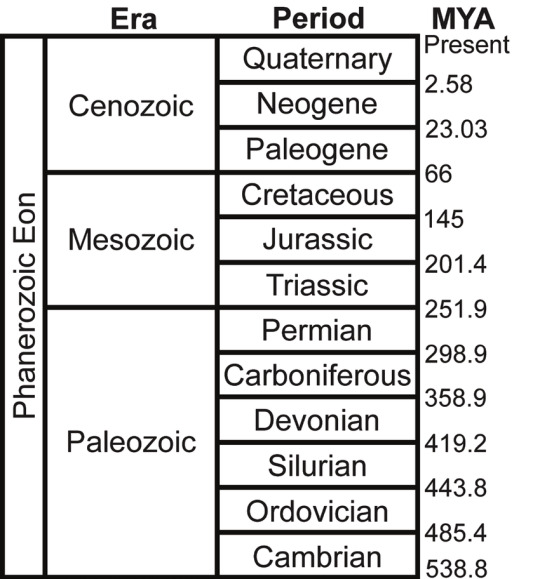
Eras are then split into periods. Like the Hadean before it, there isn’t enough evidence to split the Archean eras into periods. Again, we will use the Phanerozoic eras to show the break down starting with the Paleozoic.
The Paleozoic Era is split into six periods: the Cambrian Period,

the Ordovician Period,

the Silurian Period,
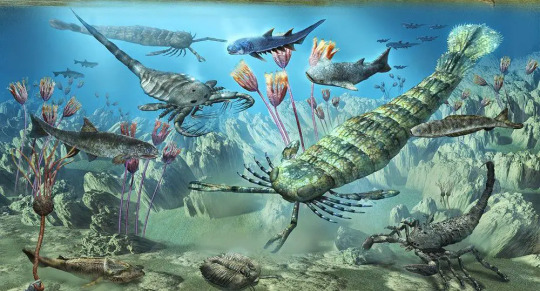
the Devonian Period,
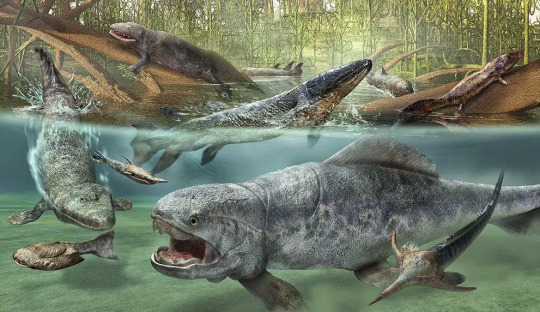
the Carboniferous Period

and the Permian Period.

These will be discussed in more detail later on down the road. I have already made posts on the Cambrian and the Ordovician Periods and this month is all about the Silurian Period.
The Mesozoic Era is split into three periods of which most people know the names: The Triassic,
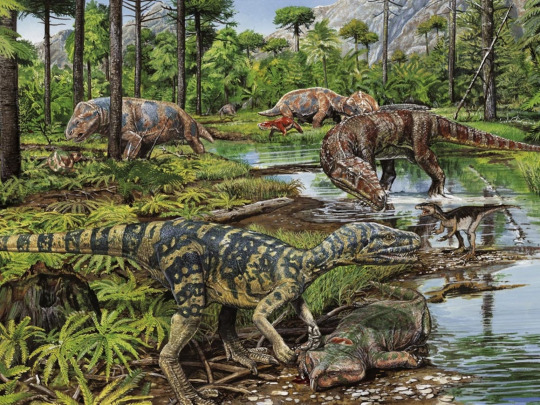
the Jurassic,

and the Cretaceous Periods.
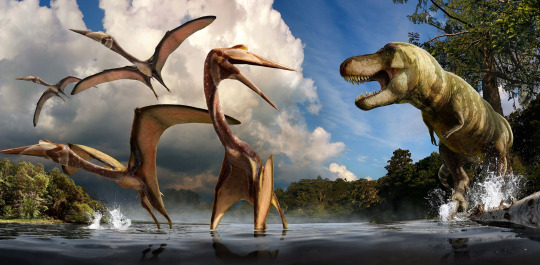
Each of these will be discussed in detail further down the road as well.
The Cenozoic Era is also split into three periods: The Paleogene Period,
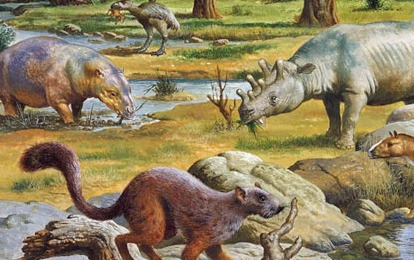
the Neogene Period,

and the Quaternary Period.

These will also be discussed in detail later.
Periods are further broken down into epochs. There are no formal epochs outside of the Phanerozoic Eon. Some early Paleozoic periods also do no have formal epochs. Many such as the Triassic and Jurassic Period are split into Early, Middle and Late. Strangely, the Cretaceous is only split into Early and Late though I think an argument could me made to create a middle.

The most well-known epochs are those of the Cenozoic Era. The Paleogene Period is split into three epochs: the Paleocene Epoch meaning “old dawn”,

the Eocene Epoch meaning “dawn”,

and the Oligocene Epoch meaning “few new”.
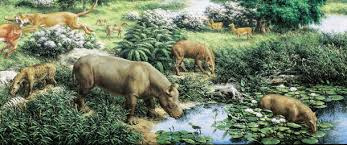
The Neogene Period is split into two epochs: the Miocene Epoch meaning “less new”
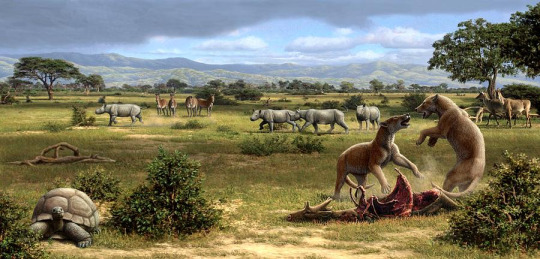
and the Pliocene Epoch meaning “more new/recent”.

The Quaternary Period is split into two epochs as well: the Pleistocene Epoch meaning “most new/recent”
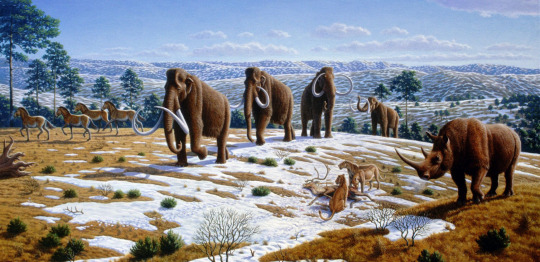
and the Holocene Epoch meaning “whole new” and is the epoch we are currently in.

Epochs can then be broken down into still smaller categories called ages. For example, the Late Jurassic Epoch is broken up into three ages: Oxfordian Age, Kimmeridgian Age and Tithonian Age.
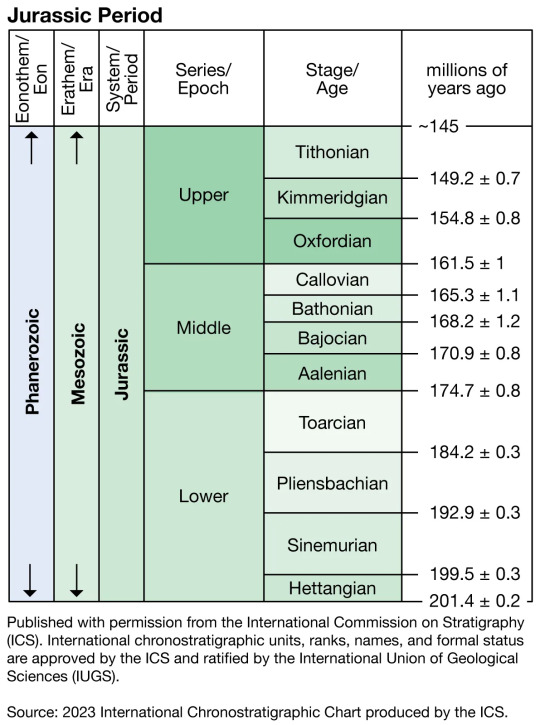
Now let’s put all these, eons, eras, periods, epochs, and ages into perspective. Let’s pretend Earth’s current lifespan is a clock. At 12:00, the Earth’s crust forms (Hadean Eon). At 2:10, the oldest rocks are preserved (Archean Eon). At 3:17, the first bacteria appear (Proterozoic Eon). At 11:52, the Cambrian Explosion occurs. At 11:53, first plants and fish. 11:54, first insects. 11:55, first reptiles and amphibians. 11:56, Mesozoic Era begins. 11:57, first dinosaurs, mammals, and birds. 11:59 Cenozoic Era.

Need a different visual? Try a calendar. The Hadean starts in January and ends halfway through February where the Archean picks up. The Archean lasts until halfway through June. From there, the Proterozoic starts and doesn’t end until about Thanksgiving. The Paleozoic Era then goes until about a week before Christmas. The Mesozoic covers Christmas to the December 30. New Year’s Eve represents the Cenozoic Era.
Thanks for coming to this lesson and make sure to tune in tomorrow for some fun trivia! Fossilize you later!

#paleontology#geology#fun facts#science education#earth science#deep time#geologic time scale#eon#paleozoic era#mesozoic#cenozoic#cambrian period#ordovician#silurian#devonian period#carboniferous#permian#triassic#jurassic period#cretaceous period#paleogene#neogene#quaternary#epoch#geologic age
114 notes
·
View notes
Text






The Famous one and the Not Quite as Famous one.
People know the Mammoth, the Smilodon, and the Wooly Rhino (Coelodonta) but they have close relatives you might like too!
Coelodonta - Elasmotherium
Mammoth - Mastodon
Smilodon - Homotherium
Stickers || Phone Wallpapers Masterlist
#art#my art#paleoart#paleontology#science#illustration#ice age#quaternary#pleistocene#coelodonta#elasmotherium#mammoth#mastodon#smilodon#homotherium
134 notes
·
View notes
Text




Cenozoic Murals - The Fernbank Museum, Atlanta, Georgia
84 notes
·
View notes
Text
Surveying Mass Extinctions - Part 2

Postosuchus, one of the crocodylomorphs of the Triassic (FunkMonk, Public Domain)
Continuing my overview of the Earth's extinction events! Part 1 covered the 'Precambrian' and Paleozoic, and so Part 2 will conclude with the Mesozoic and Cenozoic Eras.
Smithian-Spathian Boundary Event
When? - ~249.9 Million Years Ago (Olenekian Age, Early Triassic)
Cause - The Siberian Traps still had a little juice in them, and briefly experienced a few more eruptions which were enough to recharge ocean anoxia and an increase in volcanic carbon leading to global warming (Du, etal. 2022).
Victims - Life was on the road to recovery following the Great Dying, even following a massive spike in global temperatures facilitated by the loss of forests (Xu, et al. 2025). Surveys of fossil communities point to the Smithian-Spathian being particularly disruptive to regrowth: many species survived the destruction only to perish almost immediately afterward. Lystrosaurus, one of the most common of the dicynodont protomammals, went extinct, as did contemporaneous tetrapods like the archosauriform Proterosuchus. In the seas, life was hit equally hard, with losses among conodonts, ammonoids, bivalves, and other marine invertebrates, while radiolarians (amoeba-like, shelled plankton) suffered extinctions.
Survivors - It appears that bony fishes and the ancestors of marine reptiles survived through the harsh conditions, and it's widely understood that ichthyosaurs and sauropterygians (placodonts & proto-plesiosaurs) experienced an adaptive radiation afterward, preying on the many newly evolving fishes. They would become some of the major marine vertebrates of the Mesozoic Era. Among marine invertebrates, the start of the Triassic marks the origin of the "Modern Fauna", mainly composed of bivalves, gastropods, echinoderms, and crustaceans.
Carnian Pluvial Episode
When? - ~234-232 Million Years Ago
Cause - Climate warming coincides with increased moisture in the atmosphere, and it appears that the hot-house conditions of the Triassic Period facilitated the appearance of megamonsoons which dumped rains across the Pangaean supercontinent for roughly 2 million years. Such persistent rainfall affected the rock and water cycles and turned large areas of the land into humid, wetland environments (Corso, et al. 2020).
Victims - Such a change in the water cycle shifted both marine and freshwater communities, and there were extinctions among mollusks, crinoids (isocrinids died out), corals, bryozoans, conodonts, bony fishes, and planktonic forms. On land, tetrapods experienced losses, primarily among herbivorous varieties like rhynchosaurs and dicynodonts.
Survivors - The spread of wetlands encouraged the growth of new forests, and ferns, conifers, and cycadeoids (stem-angiosperms) experienced increased biodiversity. Fossil evidence points to the rise of dinosaurs, crocodylomorphs, turtles, lepidosaurs (lizards & tuataras) and mammaliaforms during the Carnian Pluvial Episode, meaning that essentially all the modern land vertebrate groups evolved, perhaps, in response to the changes (Corso, et al. 2020). In the oceans new life took root with the first scleractinian corals (the group to which modern stony corals belong), though it wasn't until several million years later when they formed a symbiotic relationship with zooxanthellae algae that coral reefs developed. Importantly, zooxanthellae belong to the dinoflagellate group, which also shared an origin during the Carnian alongside the chalk-forming coccolithophore plankton. Neopterygians - ray-finned fishes with lightened scales and skeletons - and the proto-sharks and rays (or neoselachians) experienced an adaptive radiation as well.
End Triassic Mass Extinction
When? - 201.4 Million Years Ago
Cause - Pangaea was in the beginning stages of break-up, and one of the first areas of release was between the future continents of North America and Eurasia. In the proto-North Atlantic, massive lava flows marked the boundaries of separation and are recorded in the rock record as the Central Atlantic magmatic province or CAMP (Whalen, et al. 2015). Correlations between geologic dating and the timing of extinctions have pointed strongly to CAMP being one of the leading causes of the mass extinction (Deenen, et al. 2010; Bond & Grasby, 2017). As much as 720,000 cubic-miles of lava may have pooled across the northern hemisphere (Benton, 2023). Such enormous volcanic outpourings would have contributed to climatic warming and ocean acidification & anoxia as they erupted over an estimated 600,000 year period in four pulses (Bond & Grasby, 2017).
Victims - In the oceans, the scleractinian corals faced their harshest extinction event before the present. Among the other marine losses was the total extinction of the lamprey-like conodonts, and ammonoid diversity plummeted so much that only one lineage survived to give rise to the famous ammonites of the Jurassic & Cretaceous oceans. Conulariids, a bizarre group related to jellyfish, also went extinct after having lived through the entire Paleozoic Era. On land, plants suffered a drop in biodiversity across several regions, and the CAMP was a decisive turning-point in amniote evolution. This extinction event was the death-nail for many of the crocodylomorphs and remaining therapsid protomammals (specifically dicynodonts and therocephalians), whose lines ended before the Triassic closed out. The giant temnospondyls would never recover their past diversity: metoposaurs and pelagiosaurids would go extinct. Many marine or coastal reptile groups died out, including the placodonts and long-necked tanystropheids. Reptiles as a whole were severely reduced in diversity, with parareptiles, many archosauromorphs, and the other so-called "Triassic weirdos" going extinct.
Survivors - It would be the dinosaurs who would take up the major terrestrial niches on land for the remainder of the Mesozoic, having outlasted the other reptile groups and having their own adaptive radiation. Of the therapsids, only the mammaliaforms survived to give rise to crown mammals in the Jurassic Period. Of the temnospondyls, the lissamphibians (frogs, salamanders, caecilians) would diversify across forested and wetland ecosystems. Of the marine reptiles, only the plesiosaurs and ichthyosaurs survived. Pterosaurs, the flying reptiles closely related to dinosaurs, had evolved prior to CAMP, and would go on to rule the skies.
Toarcian Oceanic Anoxic Event
When? - ~183 Million Years Ago (Early Jurassic Period)
Cause - A minor extinction event that occurred in about six pulses as a result of volcanic activity and ocean anoxia (Caruthers, et al. 2013). The eruptions of the Karoo and Ferrar Traps in South Africa have been linked, which may have also released methane as well as CO2 into the atmosphere. There is evidence to suggest extensive wildfires and acid rain affected life on land (Reolid, et al. 2022).
Victims - As a result of ocean anoxia, this event was particularly rough for shelled marine invertebrates, like ammonites, bivalves brachiopods, and ostracods. Forams, radiolarians, and dinoflagellate plankton were hit hard. Marine reptiles experienced severe losses, with a number of plesiosaur and ichthyosaur clades going extinct (including the giant predatory temnodontosaurids). Dinosaur and plant diversity appears to have been impacted by the Traps eruptions: fossil sites show a decline in gymnosperms, cycadeoids, seed ferns, true ferns, and lycopods, and there are notable extinctions of many lineages of early sauropodomorphs (traditionally known as "prosauropods") and thyreophorans (e.g. Scelidosaurus) as well as the coelophysoid predators who preyed on them (in addition to the related, double head-crested Dilophosaurus).
Survivors - Thalattosuchians, ocean-adapted crocodylomorphs seem to have taken over some of the niches of the lost marine reptile groups. Terrestrial ecosystems experienced a shift from the earlier high-diversity communities to substantially lower-diversity forests primarily composed of conifers and cycads (Slater, et al. 2019). Dinosaurs experienced a turnover in diversity, with the earlier predatory forms being replaced by allosauroids, megalosauroids, and tyrannosauroids; while the herbivores were replaced by larger and more derived sauropods, stegosaurs, and ankylosaurs (Reolid, et al. 2022). Recent evidence shows that insects may have benefited from the anoxic event by feasting on the dead fish corpses and newly-evolved plants (Swaby, et al. 2024).
Tithonian Extinction
When? - ~143 Million Years Ago (Late Jurassic Period)
Cause - An area of ongoing and controversial research, there is growing evidence of one or a number of events occurring at the end of the Jurassic Period that could be regarded as an extinction event, as there is evidence of both environmental change and faunal turnover at this time (Tennant, et al. 2016). Proposed causes include volcanic activity and even bolide impacts, which contributed to falling sea levels and a general cooling & drying of the global climate.
Victims - There is evidence of diversity loss at regional levels across many taxa, from marine mollusks to dinosaurs. Scleractinian coral reefs were badly hit, and there was a large decline in decapod crustaceans, ammonites, and bivalves; among the latter, heteroconchs (the cockle & unionid mussle clade) and lucinids (hatchet clams) experienced losses. Lineages of freshwater fishes, turtles, and plesiosaurs died out. The long-tailed pterosaurs (traditionally known as "rhamphorhynchoids") died out. Among dinosaurs, there was a particularly noticable turnover in forms: predatory ceratosaurids, megalosaurids, and allosaurids went extinct; many clades of sauropods suffered losses; and the stegosaurs lost considerable diversity.
Survivors - Rudists, a clade of bivalves, replaced the scleractinians as the ocean's major reef-building organisms for the remainder of the Mesozoic Era. Both gastropods and brachiopods seemed to have been unaffected by the changes. Marine fishes, and sharks & rays as a whole, seemed to do well, as did the reptilian ichthyosaurs and thalattosuchians. Notosuchian crocodylomorphs evolved right after the Jurassic extinction, encompassing a diverse group of land-living forms. Pterodactyloids - the short-tailed pterosaurs - persisted and underwent a burst in evolutionary change. Though the major groups of dinosaurs were more or less established long before the end of the Jurassic, it wasn't until afterward that they experienced another burst of evolution. New species of ceratopsians, ornithopods, ankylosaurs, titanosaurs, allosauroids, megalosauroids, and coelurosaurs (including new lineages of birds) evolved across the continents.

Cycadeoid, a type of stem-angiosperm (Matteo De Stefano/MUSE, CC BY-SA 3.0)
Aptian-Albian Extinction
When? - ~117-113 Million Years Ago (Early Cretaceous Epoch)
Cause - Volcanic eruptions in the South Asian Rahjamal Traps appear to have spurred a period of high global temperatures and ocean anoxia, designated at "OAE1" (Benton, 2023). The oceans, at least, experienced a cooling trend by the early Albian Age (Balestra, et al. 2025).
Victims - The Aptian Event is said to have been one of the major die-offs of foraminifera in the Earth's history, impacting populations from the Atlantic to the Tethys (Balestra, et al. 2025). Extinctions on land appear to have been more regional in scope and mainly affected plant communities: a number of ginkgo, conifer, and cycadeloid genera went extinct (Archangelsky, 2001).
Survivors - While gymnosperms, cycadeoids, and ferns as a whole did not suffer tremendous losses, the early angiosperms (flowering plants) would ultimately experience a burst in biodiversity. By 100 million years ago, the "Angiosperm Terrestrial Revolution" would bring a significant shift in the ecological relationships between plants and animals, particularly among insects and herbivorous tetrapods (Benton, et al. 2021).
Cenomanian-Turonian Extinction
When? - ~94.5-90.3 Million Years Ago (Late Cretaceous Epoch)
Cause - As in the Aptian-Albian, the oceans underwent another anoxic event - "OAE2" - that was paralleled by a sharp rise in global sea levels and temperatures (Petrizzo, et al. 2022; Arthur, et al. 1988). These are linked to volcanic lava flows in both the newly-forming Caribbean Sea and in Madagascar as it separated from the Indian Subcontinent (Kuroda, et al. 2007), but other areas of the world seem to have contributed with their own eruptions (Petrizzo, et al. 2022). The transition from the Early to Late Cretaceous Epochs was thus marked by a dynamic shift in the Earth's climate and oceans.
Victims - There was a significant turnover of Mesozoic marine life, particularly among plankton (many coccoliths, forams, radiolarians, and dinoflagellates went extinct), mollusks (many rudists and ammonites went extinct), and sea-going reptiles (ichthyosaurs and the large-headed plesiosaurs called pliosaurs went extinct). So far as can be deduced, there were no significant extinctions on land at a global level.
Survivors - The Cenomanian-Turonian would be the last time in Earth's history that a major ocean-anoxia event occurred across the world's oceans (Petrizzo, et al. 2022). Mosasaurs, a lineage of paddle-limbed lizards, would evolve to take over the role of the ocean's great predators from the pliosaurs and ichthyosaurs. On land, the drying of the climate facilitated the spread of mid-latitude open forest environments dominated by flowering trees of the Fagales clade (the oaks, birches, alders, etc) while closed-conifer araucaria & cypress forests reduced in size (Heimhofer, et al. 2018).

Impression of the K-Pg Bolide Hitting the Earth (Donald Davis, Public Domain)
End-Cretaceous Mass Extinction Event
When? - ~66.043 Million Years Ago
Cause - Since the pioneering research done by the Alvarez team in 1980, the sheer volume of studies on the world of the very latest Cretaceous Period have converged on one major consensus: a ~6.2 mile-long bolide (space rock) collided with the Earth and it was this that ultimately caused a mass extinction (Chiarenza, et al. 2020). It struck the Yucatán Peninsula with the power of over a billion nuclear bombs, landing in an area rich in carbonate and sulfate minerals (Schulte, et al. 2010). Immediate effects from the blast included enormous earthquakes and megatsunamis. It is argued that the rain of returning debris in the form of superheated glass may have triggered surface conditions comparable to an oven, and the land would have cooked and burned under a global firestorm (Robertson, et al. 2013). All this would have occurred on the first day of the impact. By having landed in carbonate & sulfate-rich terrain, particularly strong aerosols had also been ejected across the atmosphere to produce a blanket against solar radiation. This then shifted the atmosphere from fire to ice, and a prolonged impact winter would unfold over a period of years to decades (Brugger, et al. 2016). The release of aerosols also contributed to ocean acidification through acid rains. Though there is evidence of intensive and substantial volcanism on the Indian Subcontinent at the end of the Cretaceous - these being the Deccan Traps eruptions - its effects on extinctions appear to have been minimal, and in fact they may even have helped life survive in the wake of the devastation (Chiarenza, et al. 2020).
Victims - The species losses span the entire breadth of the tree of life. The most prominent extinctions were, of course, among the non-avian dinosaurs (including all but one lineage of birds), marine reptiles, and pterosaurs. There were also losses among modern reptile groups, with lizards, tuataras, and crocodylomorphs being hard hit. Mammals - typically thought of as hardy survivors - actually suffered significant extinctions too, with marsupials and multituberculates experiencing the biggest die-offs. There were broken connections between plants and insects, leading to a decline in numbers for both (Labandeira, et al. 2022). Several clades of oceanic sharks and rays, and bony fishes, went extinct. The great rudist bivalves and the reefs they formed died out, and there were large losses among the scleractinian corals too. Fellow marine invertebrates suffered both declines and extinctions, most notably the inoceramid clams (now extinct), the squid-like belemnites (now extinct), and the ammonites (extinct within about a million years of the event). As with most mass extinctions, planktonic forms suffered greatly, with coccoliths and forams experiencing another wave of extinctions.
Survivors - Freshwater animals, particularly turtles, frogs, and bony fishes, seem to have buffered against the devastation, with some forms growing exceptionally large fairly soon into the Paleogene Period. In the seas, many marine forms survived by either retreating to the depths or seeking shelter in refugia. On land, all major animal groups ultimately survived, including the dinosaurs: neornithine birds (the group to which our living forms belong) seem to have made it out against the other bird clades because they were ground-dwelling generalists. Mammals and other small tetrapods also survived by being generalists, as well as having burrowing or subsurface behaviors that allowed them to ride out the head & cold. Total recovery is estimated to have taken a few hundred thousand years as global temperatures climbed back to hothouse conditions, and the increased ash from the global wildfires appear to have fertilized the soil enough to spur a rapid growth in broadleaved angiosperms. The bolide impact gave birth to the first tropical rainforests (Carvalho, et al. 2021).
Eocene Marine Events
When? - ~41.5-37.71 Million Years Ago (Eocene Epoch)
Cause - Two little known extinction events, which appear to be linked to changes in ocean circulation (MacLeod, 2015). In the first at the Lutetian-Bartonian boundary, there is evidence of a brief period of global warming which increased runoff into the oceans, though there is as yet no evidence of increased CO2 outgassing (Intxauspe-Zubiaurre, et al. 2018). During the second at the Bartonian-Priabonian boundary, cooler waters from temperate zones flooded into warmer, tropical waters (MacLeod, 2015).
Victims - The first thermal maximum period appears to have wiped out a large diversity of gastropods, bivalves, and foraminifera, while the latter saw extinctions among foraminifera (including the last Nummulites), gastropods, bivalves, and echinoids (the urchin clade) (Less & Özcan, 2012). There are correlated extinctions on land during these times, particularly with the loss of various placental mammal groups (e.g. dinoceratans, hyopsodontids), and these may be tied to possible changes in sea levels (MacLeod, 2015).
Survivors - Beyond the losses of mollusks and plankton, most marine life appears to have made it through this period. Fossil records at European sites point to remarkable fish diversity in the following ages.
The "Grande Coupure"
When? - ~33.9-33.4 Million Years Ago (Eocene-Oligocene Epoch)
Cause - At the end of the Eocene Epoch, Antarctica had begun to acquire its permanent ice sheets following its separation from the other southern hemisphere continents and the beginnings of circumpolar ocean currents. This would have cascading effects down through the Cenozoic Era, as the Earth's average global climate would gradually shift towards cooler temperatures and more marked seasonality. Research supports a link between the increasingly rapid seasonal changes (including colder winters) and a high rate of extinctions (Ivany, et al. 2000). As sea-levels shrunk due to the expanding ice sheets, the Turgai Strait which had separated the European and greater Eurasian landmasses closed up, allowing different animals and plants to spread into new lands.
Victims - The name "Grande Coupure" means "Great Cut" and refers to a clear turnover in mammalian diversity in Europe, as their original faunas were replaced by greater-Eurasian migrants (Costa, et al. 2011). European artiodactyls or even-toed hoofed mammals (e.g. xiphodontids, amphimerycids), perissodactyls or odd-toed hoofed mammals (e.g. palaeotheres), early primates (e.g. adapids & omomyids), rodents, and lipotyphlans all suffered extinctions. There is evidence in North America of a significant turnover in smaller animals like reptiles and snails (Zanazzi, et al. 2007). In the oceans, there was a notable decline in the diversity of mollusks and other marine invertebrates (Ivany, et al. 2000), and several varieites of stem-whales (like Basilosaurus) went extinct likely as a result of poor catches.
Survivors - In Europe, the new mammals that tookover and diversified include rhinoceroses, anthracotheres & entelodonts (clades related to hippos), ancestral hedgehogs, and various rodent lineages (e.g. cricrtids, castorids), while several of the native European forms also survived relatively unscathred. In the oceans where was an increase in predatory shell-drilling snail species upon the surviving bivalves (Kelly & Hanson, et al. 1996). Both toothed and baleen whales evolved and diversified in astonishing variety.
Middle Miocene Disruption
When? - ~14 Million Years Ago
Cause - Throughout the Earth's history, Milankovitch cycles have shifted the axis and orbital eccentricity of the planet, and these shifts become noticeably pronounced when there are large areas of surface ice. It's widely believed that the most famous Ice Ages of the Quaternary Period were influenced by these cycles, but in earlier periods they had similar power (Halbourn, et al. 2005). During the preceding Neogene Period, such orbital changes shifted the circulation of ocean currents, which in-turn shifted heat transfer and spurred increased global cooling (Shevenell, et al. 2004). Further influence on ocean currents was the final closure of the Tethys, which once linked separate oceans (Hamon, et al. 2013).
Victims - Statistically, it has been argued that this was one of the largest extinction events of the Cenozoic Era (at least regarding regional extinctions) but so far concrete evidence has been lacking for many groups (MacLeod, 2015). The warm-living faunas of the northern hemisphere suffered die-offs, with losses among crocodylomorphs, turtles, and lizards (Böhme, 2003). Tundra ecosystems in Antarctica, some of the last major land communities on the continent, experienced their last breath (Lewis, et al. 2008). In the oceans, a number of foram genera went extinct, but there is little evidence for marine invertebrate extinctions.
Survivors - Those plants and animals that could migrated to more accomdating clines and adapted to the cooling of the climate, eventually giving rise in a few million years time to extensive grassland ecosystems and their herding and pack-hunting faunas.
Pliocene-Pleistocene Extinction
When? - ~3-2 Million Years Ago
Cause - As the Neogene passed into the Quaternary, and the dawn of the last Ice Age was approaching, there was a time of dynamic climatic and environmental changes. The Greenland Ice Sheet and the greater Arctic Polar Cap were forming, and the Antarctic glaciers had by then more-or-less formed. Much like in the Middle Miocene, there were shifts in ocean circulation and heat-exchange which affected the globe, and shallow coastal seas were diminished (Pimiento, et al. 2017). This was assisted by the closing of the Isthmus of Panama, which connected North and South America and further closed off ocean currents.
Victims - Marine invertebrates suffered tremendous losses, particularly in the Atlantic and Pacific Oceans as cooler conditions took over warm-adapted species. In the Caribbean Sea, coral reefs declined in spread and diversity after 2 million years ago (Budd, 2000). Recent work shows that large marine vertebrates experienced a dramatic extinction of species, with losses among whales, sharks, penguins, and sea turtles (Pimiento, et al. 2017). The connection of the western hemisphere facilitated a prolongued exchange of animals and plants between the two Americas, the Great American Biotic Interchange, which contributed to the eventual turnover (and decline) of native South American mammals by incoming North American species. In the newly-formed Afro-Eurasian landmass, there were also an increased extinction of proboscideans and other mammal groups (Cantalapiedra, et al. 2021).
Survivors - The shift to the Quaternary Ice Age promoted the evolution and adaptation of cold-adapted organisms, both on land and in the oceans. It's not until after this time that the great rorquals and other baleen whales evolved in response to the decline in larger marine predators (Slater, et al. 2017).
Late Pleistocene Megafaunal Extinctions
When? - Began roughly 80,000 Years Ago
Cause - Homo sapiens evolved across Africa by 300,000 Years Ago and there is evidence of periodic dispersals into Eurasia since that time, but it isn't until between 80 and 50,000 years ago that a wave of humans migrated from East Africa, into the Iranian Plateau, and out across the rest of the world. In contrast to other hominins like Neanderthals, early Homo sapiens lived in extensive social networks, could adapt remarkably fast to unique environments, bred fast, and relied on domestic dogs as hunting assistants. This made them very effective predators, and organisms which bred slow & few or were previously unaccustomed to a human presence (as was the case in regions like the Americas or Oceania) were the most vulnerable. Though it is true that there was a shift from glacial to interglacial conditions between the Pleistocene and Holocene epochs, so far as can be discerned from the patterns of extinction, it was human beings who ultimately wiped out the world's megafauna, the largest animals of a given ecosystem (Lemoine, et al. 2023).
Victims - Far from being considered a mass extinction, the decline consisted mainly of giant mammals, birds, and assorted non-avian reptiles. Wherever a firm human presence was established, within a few thousand years, giant marsupials, mammoths, mastodons, ground sloths, glyptodonts, horses, camels, bovids, bears, big cats, flightless birds, giant tortoises, and meiolaniid turtles went extinct. Islands were also particularly hard-hit and a tenuious link with the extinction of the New Zealand moa and Madagascan hippos, giant lemurs, and elephant birds to these earlier human dispersals, even though they occurrred within the last 2,000 years.
Survivors - Though there is even evidence of significant declines among mammals which survived into the present day (Bergman, et al. 2023), ultimately the factors in their favor were many. Some wild mammals dispersed alongside humans and settled where now-extinct forms roamed, like the moose (Meiri, et al. 2020). Others had co-evolved with humans or other hominins in the first place: hence the lack of die-offs in Africa or South Asia (Turvey, et al. 2021). Subsequent environmental changes unfolded in a world depleted of large animals, given their extensive influence on ecosystem engineering, and habitats that survived were a shell of their former selves (Svenning, et al. 2024).
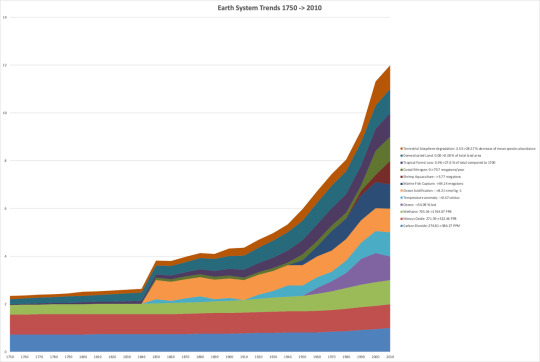
Earth System Trends of the last 300 Years (Bryanmackinnon, CC BY-SA 4.0) Larger Image
Late Holocene Mass Extinction
When? - At least 500 Years Ago, but arguably earlier
Cause - As human populations increased and the need/desire for resources like food, minerals, and territory increased, the global environment took on greater and greater stresses. While there is ample evidence of positive and negative ecological management across human history, the last 500 years of global capitalism and colonialism have had a proportionally-devastating effect on habitat destruction, defaunation, and extinction. Particularly strong drivers include (and have included) intensive agriculture, overhunting, overfishing, overharvesting, the wildlife trade, pollution & runoff, added input from CO2 & methane emissions, and widespread ignorance or apathy about any of these things (Bradshaw, et al. 2021). The conditions being created on the Earth as you read this have been compared to and understood in the context of past mass extinctions, especially in light of recent revelations: for example, it has been demonstrated that ocean anoxia, acidification, and the formation of "dead zones" is occurring in parts of the ocean today (Gobler & Baumann, 2016; Mancini, et al. 2024).
Victims - Though the extent of calculated losses has been contentious and disputed (MacLeod, 2015), recent surveys show without a doubt that a significant defaunation and extinction of lineages is occurring across all biological lineages and that we are in the beginning pains of a mass extinction event (Cowie, et al. 2025; Ceballos & Ehrlich, 2018). A 2023 analysis estimated that ~1.97 million species could become threatened with extinction due to various human activities (Hochkirch, et al. 2023), while the contributions from anthropogenic (human-induced) climate change could further accelerate extinctions with a excess of 1.5°C global average temperatures (Urban, 2024). In the oceans, in freshwater systems, and on terrestrial habitats, life is being impacted. Surveys estimate that 40.7% of amphibians, 21.1% of non-avian reptiles, 13.6% of birds, and 25.4% of mammals are threatened with extinction (Cox, et al. 2022). >40% of insects - usually outliers in past extinction events - are at risk (Sánchez-Bayo & Wyckhuys, 2019). 26% of freshwater fishes & 30% of freshwater crayfish, shrimp, and crabs are at risk (Sayer, et al. 2025). 12.7% of marine fishes are at risk (Loiseau, et al. 2024), with sharks, rays, and large bony fishes especially depleted. 44% of coral species are at risk (IUCN, 2024) and complex reef ecosystems are vulnerable to total collapse. Among mollusks, it is estimated that between 7.5-13% of described snails and clams have been wiped out since 1500 (Régnier, et al. 2017); land snails & freshwater bivalves have been especially vulnerable. Roughly 39% of vascular plants (angiosperms, gymnosperms, ferns, & lycopods) are at risk (Lughadha, et al. 2020). Overall, it has been estimated that ~30% of known species have either been killed off or threatened with extinction within the last 500 years (Isbell, et al. 2022).
Survivors - A 2023 study reported that "49% and 3% of species currently remain stable or are increasing, respectively" and that this survivability shows "a tendency to expand towards temperate climates" (Finn, et al. 2023). That said, the sheer scale of biological destruction and its multifacited human causes will almost certainly have uncalculated consequences and affect these numbers. We must recognize one key fact: this is the only extinction event in Earth's history whose definite cause (humanity) is also its solution. The very same power that has allowed humans to change the surface of the planet is the very same that can end the devastation and safeguard biodiversity (including our own wellbeing). We need only choose to do so.
Closing Thoughts
This has been a worthwhile exercise, and I have learned a lot in researching and preparing this summary of extinction events, and I have tried to be comprehensive in scope (however imperfect I might have been).
I have gathered a few key lessons in outlining the history of extinctions, and here's what I've taken to heart:
Plankton and marine invertebrates have been the backbone of understanding extinction events. In fact, their very nature as common, easily-preserved fossils is what allowed geologists and paleontologists to create the time scale of the Earth, whose major divisions have been marked by the loss or appearance of specific invertebrate fossils. They are particularly vulnerable to extinctions, and many major lineages have succumbed to death, thus altering the foundations of oceanic food webs.
Plate tectonics have been one of the major driving forces of extinction events. While the hypothesis of a "cyclicity of mass extinctions" due to cosmological phenomena has been heavily debated, there is a clear correlation between the movements of the continents and extinction events. Volcanic eruptions are usually the result of tectonic activities, and it is through them that significant ocean anoxia and climatic warming/cooling occur. As well, the closing or opening of isthmi due to continental drift have helped regulate the positions of oceanic currents. All these phenomena have been involved in the majority of the Earth's extinction events. Bolide impacts, for all their popularity as research subjects, have only truly been confirmed as harbingers of extinction for the End Cretaceous Event.
Life is resiliant, but not all-powerful. Though our fellow organisms have survived all the previously described events, it is clear that today's sample is the exception: >99% of all the species that have ever lived are now extinct. The threats to their wellbeing have been many and without warning, and the loss of even a few species or clades has upset whole ecosystems. This is all the more reason why we must do everything we can to preserve and cherish the life that still exists on the Earth. The Holocene Mass Extinction has been particularly severe and all-encompasing, and it is a fact that diversity enhances survivability in the long-term. The Great Dying took millions of years for life to fully recover, and we're basically playing out this extinction event on a significantly shorter timescale, with no clear guarantee of the outcome; we are truly living in unprecedented times. If we want to have a future worth living, we must embrace this understanding of past extinction events and rebuild our connections with life on Earth.
Special thanks to @albertonykus & @otussketching for productive conversations on the nature of extinction events.
Book Citations
Michael J. Benton. Extinctions (Thames & Hudson, 2023)
Peter Brannen. The Ends of the World (Ecco, HarperCollins, 2017)
Norman MacLeod. The Great Extinctions (Firefly Books, 2015)
Paper Citations
Luis W. Alvarez, et al. 1980. Extraterrestrial Cause for the Cretaceous-Tertiary Extinction (Science)
Sergio Archangelsky, 2001. The Ticó Flora (Patagonia) and the Aptian Extinction Event (Acta Paleobotanica)
Michael A. Arthur, et al. 1988. Geochemical and climatic effects of increased marine organic carbon burial at the Cenomanian/Turonian boundary (Nature)
Barbara Balestra, et al. 2025. Benthic foraminiferal Mg/Ca response across the Aptian-Albian Boundary Interval at DSDP Site 511 (Falkland Plateau) (Palaeogeography, Palaeoclimatology, Palaeoecology)
Michael Benton, et al. 2021. The Angiosperm Terrestrial Revolution and the origins of modern biodiversity (New Phytologist)
Juraj Bergman, et al. 2023. Worldwide Late Pleistocene and Early Holocene population declines in extant megafauna are associated with Homo sapiens expansion rather than climate change (Nature Communications)
Madelaine Böhme, 2003. The Miocene Climatic Optimum: evidence from ectothermic vertebrates of Central Europe (Palaeo)
David P. G. Bond & Stephen E. Grasby, 2017. On the causes of mass extinctions (Palaeogeography, Palaeoclimatology, Palaeoecology)
Corey J. A. Bradshaw, et al. 2021. Underestimating the Challenges of Avoiding a Ghastly Future (Frontiers)
Julia Brugger, et al. 2016. Baby, it’s cold outside: Climate model simulations of the effects of the asteroid impact at the end of the Cretaceous (Geophysical Research Letters)
A. F. Budd, 2000. Diversity and extinction in the Cenozoic history of Caribbean reefs (Coral Reefs)
Juan L. Cantalapiedra, et al. 2021. The rise and fall of proboscidean ecological diversity (Nature Ecology and Evolution)
Andrew H. Caruthers, et al. 2013. The Pliensbachian–Toarcian (Early Jurassic) extinction, a global multi-phased event (Palaeogeography, Palaeoclimatology, Palaeoecology)
Mónica R. Carvalho, et al. 2021. Extinction at the end-Cretaceous and the origin of modern Neotropical rainforests (Science)
Gerardo Ceballos & Paul R. Ehrlich, 2018. The misunderstood sixth mass extinction (Science)
Alfio Alessandro Chiarenza, et al. 2020. Asteroid impact, not volcanism, caused the end-Cretaceous dinosaur extinction (PNAS)
Jacopo Dal Corso, et al. 2020. Extinction and dawn of the modern world in the Carnian (Late Triassic) (Science Advances)
Elisenda Costa, et al. 2011. The age of the “Grande Coupure” mammal turnover: New constraints from the Eocene–Oligocene record of the Eastern Ebro Basin (NE Spain) (Palaeogeography, Palaeoclimatology, Palaeoecology)
Robert H. Cowie, et al. 2025. Denying that we may be experiencing the start of the Sixth Mass Extinction paves the way for it to happen (Trends in Ecology & Evolution)
Neil Cox, et al. 2022. A global reptile assessment highlights shared conservation needs of tetrapods (Nature Portfolio)
M.H.L. Deenen, et al. 2010. A new chronology for the end-Triassic mass extinction (Earth and Planetary Science Letters)
Yong Du, et al. 2022. A massive magmatic degassing event drove the Late Smithian Thermal Maximum and Smithian–Spathian boundary mass extinction (Global and Planetary Change)
Catherine Finn, et al. 2023. More losers than winners: investigating Anthropocene defaunation through the diversity of population trends (Biological Reviews)
Christopher J. Gobler & Hannes Baumann, 2016. Hypoxia and acidification in ocean ecosystems: coupled dynamics and effects on marine life (Biology Letters)
Ann Holbourn, et al. 2005. Impacts of orbital forcing and atmospheric carbon dioxide on Miocene ice-sheet expansion (Nature)
L. Hamon, et al. 2013. The role of eastern Tethys seaway closure in the Middle Miocene Climatic Transition (ca. 14 Ma) (European Geosciences Union)
Ulrich Heimhofer, et al. 2018. Vegetation response to exceptional global warmth during Oceanic Anoxic Event 2 (Nature Communications)
Axel Hochkirch, et al. 2023. A multi-taxon analysis of European Red Lists reveals major threats to biodiversity (PLOS One)
Beñat Intxauspe-Zubiaurre, et al. 2018. The last Eocene hyperthermal (Chron C19r event, ~41.5 Ma): Chronological and paleoenvironmental insights from a continental margin (Cape Oyambre, N Spain) (Palaeogeography, Palaeoclimatology, Palaeoecology)
Forest Isbell, et al. 2022. Expert perspectives on global biodiversity loss and its drivers and impacts on people (Frontiers in Ecology and the Environment)
IUCN Red List Press Release, 2024. Over 40% of coral species face extinction (IUCN)
Linda C. Ivany, et al. 2000. Cooler winters as a possible cause of mass extinctions at the Eocene/Oligocene boundary (Nature)
Patricia H. Kelley & Thor A. Hansen, 1996. Recovery of the naticid gastropod predator-prey system from the Cretaceous-Tertiary and Eocene-Oligocene extinctions (Geological Society, London)
Junichiro Kuroda, et al. 2007. Contemporaneous massive subaerial volcanism and late cretaceous Oceanic Anoxic Event 2 (Earth and Planetary Science Letters)
Conrad C. Labandeira, et al. 2002. Impact of the terminal Cretaceous event on plant–insect associations (PNAS)
Rhys Taylor Lemoine, et al. 2023. Megafauna extinctions in the late-Quaternary are linked to human range expansion, not climate change (Anthropocene)
György Less & Ercan Özcan, 2012. Bartonian-Priabonian larger benthic foraminiferal events in the Western Tethys (Austrian Juurnal of Earth Sciences)
Adam R. Lewis, et al. 2008. Mid-Miocene cooling and the extinction of tundra in continental Antarctica (PNAS)
Nicolas Loiseau, et al. 2024. Inferring the extinction risk of marine fish to inform global conservation priorities (PLOS Biology)
Eimear Nic Lughadha, et al. 2020. Extinction risk and threats to plants and fungi (Plants, People, Planet)
A. M. Mancini, et al. 2024. The past to unravel the future: Deoxygenation events in the geological archive and the anthropocene oxygen crisis (Earth-Science Reviews)
Meirav Meiri, et al. 2020. Population dynamics and range shifts of moose (Alces alces) during the Late Quaternary (Journal of Biogeography)
Maria Rose Petrizzo, et al. 2022. Biotic and Paleoceanographic Changes Across the Late Cretaceous Oceanic Anoxic Event 2 in the Southern High Latitudes (IODP Sites U1513 and U1516, SE Indian Ocean) (Paleoceanography and Paleoclimatology)
Catalina Pimiento, et al. 2017. The Pliocene marine megafauna extinction and its impact on functional diversity (Nature Ecology and Evolution)
Claire Régnier, et al. 2017. Measuring the Sixth Extinction: what do mollusks tell us? (The Nautilus)
M. Reolid, et al. 2022. Impact of the Jenkyns Event (early Toarcian) on dinosaurs: Comparison with the Triassic/Jurassic transition (Earth-Science Reviews)
Douglas S. Robertson, et al. 2013. K-Pg extinction: Reevaluation of the heat-fire hypothesis (JGR Biogeosciences)
Francisco Sánchez-Bayo & Kris A.G. Wyckhuys, 2019. Worldwide decline of the entomofauna: A review of its drivers (Biological Conservation)
Catherine A. Sayer, et al. 2025. One-quarter of freshwater fauna threatened with extinction (Nature)
Peter Schulte, et al. 2010. The Chicxulub Asteroid Impact and Mass Extinction at the Cretaceous-Paleogene Boundary (Science)
Amelia E. Shevenell, et al. 2004. Middle Miocene Southern Ocean Cooling and Antarctic Cryosphere Expansion (Science)
Graham J. Slater, et al. 2017. Independent evolution of baleen whale gigantism linked to Plio-Pleistocene ocean dynamics (Proceedings of the Royal Society B)
Sam M. Slater, et al. 2019. Substantial vegetation response to Early Jurassic global warming with impacts on oceanic anoxia (Nature Geoscience)
Felisa A. Smith, et al. 2018. Body size downgrading of mammals over the late Quaternary (Science)
Jens-Christian Svenning, et al. 2024. The late-Quaternary megafauna extinctions: Patterns, causes, ecological consequences and implications for ecosystem management in the Anthropocene (Extinction)
Emily J. Swaby, et al. 2024. The fossil insect assemblage associated with the Toarcian (Lower Jurassic) oceanic anoxic event from Alderton Hill, Gloucestershire, UK (PLOS One)
Jonathan P. Tennant, et al. 2016. Biotic and environmental dynamics through the Late Jurassic–Early Cretaceous transition: evidence for protracted faunal and ecological turnover (BRCPS)
Samuel T. Turvey, et al. 2021. Late Quaternary megafaunal extinctions in India: How much do we know? (Quaternary Science Reviews)
Lisa Whalen, et al. 2015. Supercontinental inheritance and its influence on supercontinental breakup: The Central Atlantic Magmatic Province and the breakup of Pangea (Geochemistry, Geophysics, Geosystems)
Zhen Xu, et al. 2025. Early Triassic super-greenhouse climate driven by vegetation collapse (Nature Communications)
Mark. C. Urban, 2024. Climate change extinctions (Science)
Alessandro Zanazzi, et al. 2007. Large temperature drop across the Eocene–Oligocene transition in central North America (Nature)
#paleontology#prehistoric life#paleoblr#palaeoblr#deep time#mass extinction#extinction events#extinction#Mesozoic#Triassic#Jurassic#Cretaceous#Cenozoic#Paleogene#Neogene#Quaternary#Holocene#Anthropocene#marine invertebrates#prehistoric animals#marine biology#animals#wildlife#conservation#plants#fossils#vertebrate paleontology#dinosaurs#reptiles#amphibians
27 notes
·
View notes
Text
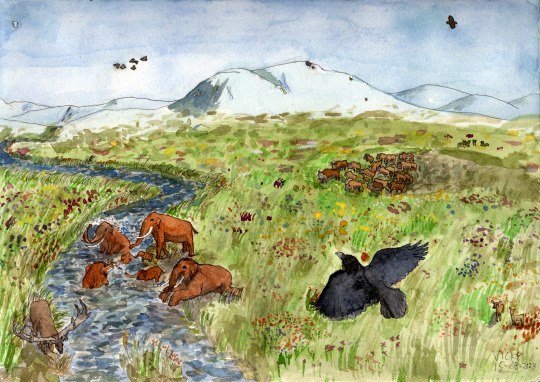
350000 years ago, just beyond the western edge of the icy Schwarzwald, spring has come to the mammoth steppe. A raven flies over a group of steppe mammoths enjoying a cold bath in the Oos river, while a Megaloceros grazes on some choice plants growing on the riverbanks. With the harsh ice age winter in retreat for a few months, a flock of greylag geese migrates north, a buzzard hunts, and a small pack of wolves observe a herd of steppe bison and some roe deer.
#steppe mammoth#raven#megaloceros#steppe bison#roe deer#wolf#buzzard#greylag goose#mammoth#proboscid#mammal#corvid#passerine#bird#deer#artiodactyl#bovid#canine#carnivore#quaternary#pleistocene#paleoart#my art#ice age#spring#mammoth steppe#schwarzwald#palaeoblr
157 notes
·
View notes
Text


The Seaside Sketches through Time!!! Now complete with Devonian, Jurassic, Eocene and Quaternary seas! With a U.S quarter for scale!
#art#rustleddoodles#artists on tumblr#illustration#paleontology#dinosaurs#doodle#my stuff#devonian#jurassic#eocene#quaternary#ornithocone#ammonite#palaeoblr#paleo art#Kronosaurus#basilosaurus#great white shark
22 notes
·
View notes
Text
✨ PREHISTORIC CHALLENGE ✨
(part 2 because I couldn't fit all the art in one post)
And here's the final art of my #PrehistoricChallenge featuring the Neogene and Quaternary.
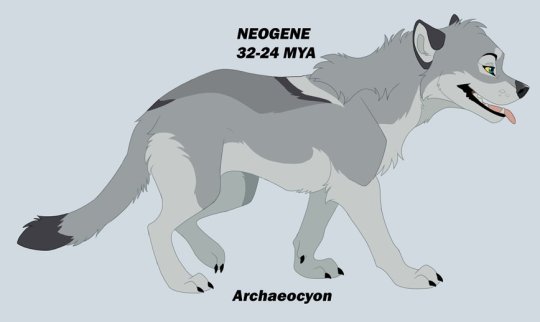
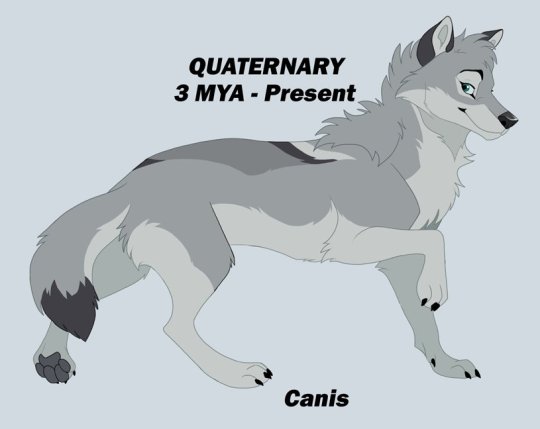
#PrehistoricChallenge#my art#fursona#drawing challenge#paleoart#neogene#quaternary#archaeocyon#canis#aspenwynd
14 notes
·
View notes
Text

"Vue idéale de la terre pendant la période quaternaire" [Ideal view of the earth during the Quaternary period] by Edouard Riou, from La terre avant le déluge [The world before the deluge] by Louis Figuier, 1863
#edouard Riou#la terre avant le deluge#world before the deluge#louis figuier#1863#Quaternary#Ice Age#cave bear#ursus spelaeus#cave hyena#Hyaena spelaeus#megaloceros#mammoth#rhinoceros
6 notes
·
View notes
Text
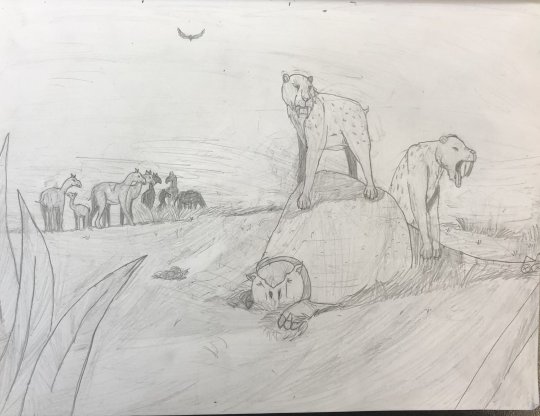
In Argentina 50,000 years ago, two Smilodon populator brothers climb on a deceased Doedicurus clavicaudatus to get a better view, while a herd of Macrauchenia patachonica roam nearby.
#paleoart#cenozoic#quaternary#pleistocene#smilodon#prehistoric#argentina#south america#macrauchenia#doedicurus#grassland#traditionalart
17 notes
·
View notes
Text
SciTech Chronicles. . . . . . . . .July 16th, 2025
#Tintina#Quaternary#“fault scarp”#“oral history”#end-on#side-on#triamidoamine#nitride#“quantum mechanics”#gravity#spacetime#families#“digital watchkeeping”#“collision avoidance”#MEGURI2040#“Orca AI”#transcription#genome#maize#bioinformatics
0 notes
Text

“In the course of twenty million years, mammals got more and more successful until they were the biggest, fiercest, and most spectacular animals on the planet. Whatever the climate, whatever the habitat, mammals made it their own. Their great strength was their ability to adapt. They grew to gigantic sizes, they evolved into powerful killers like the famous sabre-tooth cats, and they even laid claim to the oceans.”
- Kenneth Branagh, prologue to “Walking with Beasts”
Sketches of some of the incredible wildlife of the Cenozoic Era. None of the animals are exactly shown to scale. From left to right, bottom to top:
Arctocyon, Barylambda, Coryphodon, Titanoboa
Uintatherium, Notharctus, Mesonyx, Eobasileus
Leptictidium, Gastornis, Propaleotherium, Titanomyra, Godinotia, Pakicetus, Ambulocetus
Apidium, Arsinotitherium, Andrewsarchus, Embolotherium, Moeritherium, Dorudon, Basilosaurus, Perucetus
Megacerops, Cainotherium, Merycoidodon
Cynodictis, Paraceratherium, Hyaenodon gigas, Chalicotherium, Paraentelodon
Gentilicamelus, Amphicyon, Daeodon, Moropus, Dinocrocuta, Platybelodon, Gomphotherium, Pelagornis, Purussasaurus, Odobenoceratops, Otodus megalodon
Phoruschracos, Astrapotherium, Teleoceras, Synthetoceras, Samotherium, Livyatan
Australopithecus afarensis, Deinotherium, Ancylotherium, Dinofelis
Mammuthus columbi, Smilodon fatalis, Bison latifrons, Aenocyon dirus, Arctodus simus, Panthera atrox, Titanotylopus, Equus hersternus, Sivatherium, Gigantopithecus, Paleoloxodon
Smilodon populator, Macrauchenia, Doedicurus, Megatherium, Glyptodon, Toxodon
Mammuthus primigenius, Megaloceros giganteus, Coelodonta antiquitatis, Bos primigenius, Homo neanderthalensis, Elasmotherium, Bison bonasus
#paleoart#paleontology#cenozoic mammal#cenozoic animals#cenozoic mammals#cenozoic era#cenozoology#cenozoic#palaeontology#paleoartist#artists on tumblr#paleoartists on tumblr#paleoblr#paleogene#neogene#quaternary#paleocene#eocene#oligocene#miocene#pliocene#pleistocene#palaeoart#paleo#palaeoblr#paleoillustration
62 notes
·
View notes
Text
1) Gayane Logic - Four-valued (Multi-Valued) logic.
It is difficult to imagine the future of information technology with classical binary system. Moreover, today there are already implementations non-classical logical technologies and models. But the author of this article initially focused not on technology, but on humanitarian logic — logic as a humanities science.
And you can immediately ask the question: “Is there a non-humanitarian logic?” Of course, there is, if we understand logic as a system of operands and operators to perform “mental actions” of devices and programs with correct results.
It is quite logical to ask another question: “It is worth taking as a basis computers not humanitarian logic?
Here opinions may differ on what the implementation is based on computing system, purpose of computing, how efficient translate into human language, etc.
It is unlikely to find a person who has become familiar with logic and who is satisfied binary logic. Already on an intuitive level, a person asks the question: “Where is the uncertainty?” Where is the gradation between truth and falsehood? Where time factor? Yesterday it was a lie, today it might be true. And many, many legitimate questions.
I will not give all the questions that I asked myself, firstly, I don’t I remember everything, I didn’t pay deep attention to everyone, and I don’t want to distract you too many aspects of logic. I chose two logical systems, with their specificities, possible implementations, “philosophy”. They are not are random sets of operands or free self-consistency.
Although at the initial stage I coordinated them with the binary system, for the sake of practice on classical computers, with classical operations.
Four-digit logic, six-digit logic, multivalued logic.
#philosophy#logic#it#multivalued logic#quaternary logic#GayaneLogic#MVL#non-classical logic#Discrete#Math#quaternary
1 note
·
View note
Text


Bison! I have the Giant Bison and the Steppe Bison.
They're close relatives, but their horns are still quite a difference.
Stickers || Phone Wallpapers Masterlist Planned or in the works: Auroch
64 notes
·
View notes
Text









Smilodon populator, Glyptodon clavipes, and Panochthus tuberculatus fossil replicas - The Fernbank Museum, Atlanta, Georgia
47 notes
·
View notes